#john i of portugal
Text
#JON SNOW FORTNIGHT EVENT 2023 @asoiafcanonjonsnow
DAY 10: ECHOES OF THE PAST 🗝️📜 (1/2) ->
Historical parallels with Medieval bastard Kings.
Nowadays, ‘bastard’ is used as an insult.
Being born to unmarried parents is largely free of the kind of stigma and legal incapacities once attached to it in Western cultures, but it still has echoes of shame and sin. The disparagement of children born outside of marriage is often presumed to be a legacy of medieval Christian Europe, with its emphasis on compliance with Catholic marriage law.
Yet prior to the 13th century, legitimate marriage or its absence was not the key factor in determining quality of birth. Instead, what mattered was the social status of the parents – of the mother as well as of the father. Being born to the right parents, regardless of whether they were married according to the strictures of the church, made a child seem more worthy of inheriting parents’ lands, properties and titles.
It’s not until the late 12th century that evidence for the exclusion of children from succession on the grounds of illegitimate birth first appears. ‘Bastard’, as we now understand it, began to emerge here.
Importantly, this shift in the meaning and implications of illegitimacy did not arise as an imposition of Church doctrine. Instead, ordinary litigants began exploiting bits of Church doctrine to suit their own ends. Perhaps the earliest signs of this can be found in the annals of English legal history, with the Anstey case of the 1160s. This might have been the first time an individual was barred from inheriting because her parents had married illegally. And it happened not because the Church intervened, but because one clever plaintiff figured out how to exploit some scraps of theological doctrine. After that time, more and more plaintiffs began to do the same.
For example, towards the end of the 12th century, a regent countess of Champagne rushed to make use of an allegation of illegitimate birth against her nieces, in an effort to secure her son’s succession. Daughters could inherit in this region, and so these sisters did have a claim to the county once ruled by their late father. But the regent countess denounced the sisters as the product of an illegal marriage and therefore not legitimate heirs of their father. The strategy worked in that both daughters did eventually renounce their claims to the county, but not without first obtaining a great deal of money, enough to make them both extremely wealthy. As this suggests, the papacy had a far more passive role than is often imagined.
As bastardy began to acquire its modern meaning, in the early 13th century, it remained the case that the papacy focused on the regulation of illicit unions rather than the exclusion from succession or inheritance of those born to illicit unions. Hatred of illicit sex did trump dynastic politics on occasion. Hatred of the children born to such unions did not. There is very little evidence to suggest that an interest in keeping illegitimate children from inheriting noble or royal title outweighed political or practical considerations in the same way that the policing of illegal marriages sometimes did.
Understanding the changing meanings of bastardy helps us to arrive at a clearer picture of the workings and priorities of medieval society before the 13th century. Society then did not operate subject to rigid Christian canon law rules. Instead, it measured the value of its leaders based on their claims to celebrated ancestry, and the power attached to that kind of legitimacy. To be sure, marrying legitimately certainly received a good deal of lip service throughout the Middle Ages. Nevertheless, in this pre-13th-century world, the most intense attention was paid not to the formation of legitimate marriages, but to the lineage and respectability of mothers. Only beginning in the second half of the 12th century did birth outside of lawful marriage begin to render a child illegitimate, a ‘bastard’, and as such potentially ineligible to inherit noble or royal title.
Source
Well, George R.R. Martin has been using real life historical events as an inspiration for creating the lore of A Song of Ice and Fire, more concretely English and Western Late Medieval Europe history for Westeros, and it was precisely in the Late Middle Ages when the legal situation for bastards worsened by reinforcing marriage and legitimacy laws, reinforcing concubinates to disappear and laws to avoid any kind of polygamy.
In Westerosi society there's the stigma that comes from being born as a bastard, they're said to be born from lust, lies, and weakness, and as such, they are said to be wanton and treacherous by nature, and although they could get some prominent position either in the Citadel, the Kingsguard, Night's Watch or the Faith, they are generally discriminated by other Westerosi (except in Dorne, where there's tolerance towards bastards) and they rarely inherit his father's titles nor become kings. In the Asoiaf lore, there's recording of a bastard of a Bracken and a Blackwood, Benedict Waters, who founded the House of Justman and became King of the Trident as Benedict I; as well as Alyn Velaryon, a Velaryon bastard who was legitimised and became Lord of the Tides after The Dance of Dragons.
Till the events of the published books, Jon has reached the position as Lord Commander of the Night's Watch and King Beyond the Wall in all but in name, two positions he has been chosen for.
But he would not have the possibility to inherit any title as Lord of Winterfell and Warden of the North/King in the North as a bastard, unless someone legitimised him, like Robb did in his Will. Jon has the chance of standing as a candidate for the Northern Succession Council after defeating the Boltons.
So, if The North stays away from the Iron Throne, Jon would be a good candidate for Lord of Winterfell and King in The North, but the question is... Is there any historical example of bastards who became kings?
Yes, there are, and in this meta we're going to down through history and remember those kings. This list probably doesn't include all of the bastard kings, just a selection, if you know about some more, feel free to share it.
The most common concept for bastardy is a child born of parents who were not married when the child was born, so firstly we'll list a few kings who are included in that group, as we consider Jon as Eddard Stark's bastard or Rhaegar and Lyanna's.
Their circumstances in which those kings got to throne are diverse, but we'll get into them searching for any simmilarities between Jon's story and their lifes.
Let's start, the list is on chonological order, and we'll notice that after the 13th century the amount of bastard kings is less, like we cited at the beginning of this meta.
8th Century
-> Mauregato I of Asturias (719-788), who reigned during the late 8th century, between 783 and 788, and was the son of Alfonso I of Asturias and a Muslim concubine or servant named Sisalda. He took the throne when the nobility had declared his nephew Alfonso II of Asturias as Silo's successor, although he probablyhad support of some parts of the nobility. He wed Creusa and had a son with her, Hermenegildo. Bermudo I was elected as King of Asturias after Mauregato died.
The identity of Mauregato's mother is a bit unclear, but her being a Muslim servant is considered a common statement, so his parents followed religions, Christianism and Islam, like Rhaegar and Lyanna, the Faith and the Old Gods.
Plus as happened to Mauregato, Jon may have some problems of nobles in the Northern Great Council because he's bastard and the other candidates would have support for being legimate, although they are kids, they would need a regent, that could be beneficial for them to control the North if they want to, but maybe some other members of the Council suggest or support Jon as their leader.
11th Century
-> Ramiro I of Aragon (1006/7-1063), natural son of Sancho III of Pamplona and Sancha de Aybar. His father Sancho splited his domains and passed down one of them to his sons; from the offspring she had with his wife Muniadona of Castile: García III inherited the Kingdom of Pamplona, Ferdinand I of Leon inherited the county of Castile and Gonzalo inherited the counties of Ribagorza & Sobrarbe; and Ramiro received the county of Aragon, and he annexed the counties of Ribagorza & Sobrarbe Gonzalo died. He unified the three counties to create the Kingdom of Aragon. His relationship with his siblings was complex, due to the rivalry between them for their kingdoms, initially Ramiro tried to conquer Pamplona but he was defeated by García III, and later Ramiro allied with García and his son Sancho IV against Ferdinand I.
His reign lasted 28 years.
Ramiro married Ermesinda of Foix and Agnes of Aquitaine, their offspring was: Sancho I of Aragon & V of Pamplona, Sancha, García, Urraca and Theresa, and he had a son named Sancho out of wedlock.
-> Magnus I " the Good" of Norway and Denmark (1024 - 1047), son of Olaf II of Norway and English concubine named Alvhild. His reign lasted 12 years. When he was 4 year old, his father was dethroned by Cnut the Great, and then his family travelled through other courts seeking shelter but finally they stablished in at the court of the Grand Prince Yaroslav I of Novgorod, where he grew up, was trained as a warrior and was educated in Old Russian and Greek. Olaf was killed when he reurned to Scandinavia to fight for the throne. When Cnut left for England wife Ælfgifu and their son Svein as regents, Magnus and his supporters return to Norway and he was proclaimed king of Norway. Another son of Cnut, Harthacnut of Denmark, reclaimed Norway, but after Harthacnut died Magnus took his kingdom, but he had to face another pretender Sweyn II, Cnut's nephew, whom Magnus battled against using his father's battle axe, Hel, and he was successful, but died, and Sweyn II succeeded him as King of Denmark and Harald III as King of Norway.
-> William I the Conqueror (1028-1087), illegitimate son of Duke Robert I of Normandy and Herleva of Falaise. He was duke of Normandy and conqueror and king of England.
He started the conquest of England after his cousin, Edward the Confessor died without issue, and Harold II inherited the English throne, but he was defeated and William became the first king of England of the House of Normandy.
William and his wife Matilda of Flanders had 9 children: Robert I of Normandy, Richard, William II of England, Henry I ofEngland, Adelaide, Cecily, Matilda, Constance and Adela .
William seems to be the inspiration for Aegon I the Conqueror and his bastard brother Orys Baratheon, but he could have in common with Jon in becoming kings after their cousins died without issue (i.e. Robb) and having to defeat someone else to become kings, i.e. Jon helping Stannis to defeat the Boltons.
-> Harald III "Hen" of Denmark (1040-1080), illegitimate son of Sweyn II of Denmark and a concubine, Thora.
After Sweyn II died, Harald got elected over his brother Cnut by an assembly, and faced opposition from his brothers during his reign. He ruled over 6 years, he's known to be a peaceful ruler and introduced some monetary and legal reforms like substituting trial by combat or trial by ordeal and replace it with avsystem used by the English of calling upon honorable men to swear oaths on behalf of the parties in a trial.
Harald was married to his cousin Margareta Hasbjörnsdatter, but did not leave any heirs, and was succeeded by his brother Canute IV.
-> Cnut IV "the Holy" of Denmark (1040-1086), illegitimate son of Sweyn II of Denmark with an unknown concubine. He succeeded his brother Harald.
Cnut is considered an ambitious and strict king, ruled during 6 years, limited the power of the nobility, gave great concession and donations to the Church, and took the property of a great quantity of common land for himself or the Church. He raided England a few times and created a fleet to invade it, since he considered William I an usurper, but on his way to lead the invasion, he was killed during a peasant revolt.
After he died, he was succeeded by his brother Olaf I of Denmark.
Cnut married Adela of Flanders. They had three children: Charles I of Flanders and the twin sisters Cæcilia and Ingerid. Ingerid's descendants, the House of Bjelbo, would ascend to the throne of Sweden and Norway and Canute IV's blood returned to the Danish throne in the person of Olaf II of Denmark.
->Olaf I "Hunger" of Denmark (c. 1050 – 1095) illegitimate son of Sweyn II of Denmark with an unknown concubine.
In his early years he was set aside and mistreatred and exiled by his brothers, who Ferrer he could be a political rival against them.
He succeeded his brother Cnut IV, and his reign lasted 9 years, that were plagued by several consecutive years of crop failure and famine.
Olaf married Ingegard of Norway, they didn't have any offspring, so he was succeeded by his brother Erik I.
11th Century/12th Century
-> Erik I " Evergood" of Denmark (c. 1060 – 1103), illegitimate son of Sweyn II of Denmark with an unknown concubine.
When he was young he was a supporter of his brother Cnut IV. After Olaf died, Erik was elected as new king.
Erik reign lasted 8 years, he was well liked by people, he was considered a strapping young man and a good speaker and diplomat, and ruthless towards pirates and robbers. Erik had a reputation as a loud man who liked parties, and even killed four of his men while he was drunken during one of his parties, and so he procced to go on pilgrimsge to Holy Land, journey in which he died. His brother Niels succeeded him.
Erik married Boedil Thurgotsdatter and had one legitimate son with her, Canute Lavard, father of Vademar I of Denmark. Eric had four children out of wedlock, Erik II of Denmark, Benedict, Harald Kesja and Ragnhilde, mother of Erik III of Denmark.
-> Niels I of Denmark (c. 1065 – 25 June 1134) illegitimate son of Sweyn II of Denmark with an unknown concubine. He was the last son of Sweyn to become king.
He was described as mild and forthcoming, though not a competent ruler.
Niels married Margaret Fredkulla, and had two children with her, Inge Nielsen and Magnus I of Sweden. He had a daughter born out of wedlock, Ingerd of Denmark.
During the majority of Niels' reign, 30 years, Denmark had internal peace, only broken when his son Magnus was forced from the Swedish throne and a conflict erupted between Magnus and his cousin Cnut Lavard, due to his popularity. After Magnus slew Cnut, Erik II took his brother's place in the conflict, and Niels supported Magnus.
Niels and Magnus died during the civil war and Erik II became king of Denmark.
-> Erik II "the Memorable" of Denmark (c. 1090– 1137 ), illegitimate son of Eric I of Denmark with an unknown concubine.
Erik the Memorable rebelled against his uncle Niels, and was declared king in 1134.
He punished his adversaries severely, and rewarded his supporters handsomely, as he was considered a harsh and unpopular ruler, he only ruled Denmark 3 years. He was killed by a subject in 1137 and was promptly succeeded by his nephew Erik III of Denmark.
Erik married Malmfred of Kiev, they had no issue, but Erik had a son with his concubine Thunna, Sweyn III of Denmark.
12th Century
-> Sweyn III of Denmark (1125-1157), illegitimate son of Erik II of Denmark and a concubine named Thunna.
He was elected king after Erik III of Denmark abdicated.
In 1154, Sweyn was overthrown by an alliance between Canute and Valdemar, who was crowned Canute's co-ruler as Valdemar.
This prompted the Danish magnates to force through a tripartition of the kingdom into Jutland, Zealand, and Scania. Sweyn chose first, and was made the ruler of Scania.
After that Sweyn organised apeace banquet, in which Sweyn planned on killing his two co-rulers, and succeeded in having Canute killed, but Valdemar escaped. After that Valdemar and Sweyn battled, Sweyn was killed while he was scaping from the battle. Valdemar I was proclaimed king of all Denmark.
Sweyn married Adela of Meissen, daughter of Conrad, Margrave of Meissen, and Luitgard of Ravenstein. They had two children Erik and Luitgard, who married Berthold I of Istria.
->Tancred I of Sicily ( 1138 – 1194), or Tancred of Lecce, illegitimate son of Roger III, duke of Apulia, eldest son of Roger II of Sicily, and his mistress Emma of Lecce.
Tancred was born in Lecce and inherited the county from his grandfather.
With his bastard uncle Simon plotted to remove William II, legitimate son of Roger II, but failed and went to exile.
Years after, Tancred returned to Sicily he swore fealty to his aunt Constance I as William II's heiress, Tancred rebelled and was crowned as King of Sicily. Constance I and her husband the Holy Roman Emperor Henry IV fought against Tancred. Tancred died during the war after 5 years of reign, and was briefly succeeded by his son William III, who was soon captured and executed by orders of Henry IV.
Tancred had married Sybilla of Acerra, an their children were: Roger III, William III, Elvira, Constance, Medania and Valdrada.
13th Century
->Manfred I of Sicily (1232 – 1266), natural son of Holy Roman Emperor Frederick II with Bianca Lancia, legitimised later by his father.
Manfred became regent over the kingdom of Sicily on behalf of his nephew Conradin. As regent he subdued rebellions in the kingdom, until in 1258 he usurped Conradin's rule. After an initial attempt to appease Pope Innocent IV he took up the ongoing conflict between the Hohenstaufens and the papacy through combat and political alliances. He defeated the papal army at Foggia. Manfred was excommunicated by three successive popes, Manfred was the target of a Crusade called by the Popes Alexander IV and Urban IV.
Urban received the help of Charles of Anjou in overthrowing Manfred. Manfred was killed during his defeat by Charles at the Battle of Benevento, and Charles became King of Sicily as Charles I after having executed Conradin.
Manfred had married Beatrice of Savoy and Helena Angelina Doukaina, their children were Constance II of Sicily, Beatrice, Henry, Anselm and Frederick. He also had an illegitimate daughter, Flordelis.
His daughter Constance II married Peter III of Aragon, and with their supporters in the island of Sicily fought against Charles I, who, of the whole kingdom (the Kingdom of Sicily in that period was formed by Naples and the island of Sicily) now controlled only Naples, and Constance II and her children gained Sicily, that later became part of the Crown of Aragon, and their descendants Kings of Aragon annexed Naples some generations later, and Naples and Sicily were ruled by the same king again under the reigns of Alfonso V and his nephew Ferdinand II of Aragon & his descendants.
14th Century
-> Henry II "the Fratricidal" of Castile (1334-1379), or Henry of Trastámara, illegitimate son of Alfonso XI of Castile and his mistress Leonor de Guzmán.
Henry was the fourth of ten illegitimate children of King Alfonso XI of Castile and Eleanor de Guzmán, a great-granddaughter of Alfonso IX of León. He was born a twin to Fadrique Alfonso, Lord of Haro, and was the first boy born to the couple that survived to adulthood.
At birth, he was adopted by Rodrigo Álvarez de las Asturias. Rodrigo died the following year and Henry inherited his lordship of Noreña. His father later made him Count of Trastámara and lord over Lemos and Sarria in Galicia, and the towns of Cabrera and Ribera, which constituted a large and important heritage in the northwest of the peninsula. It made him the head of the new Trastámara dynasty, a bastard branch from the Castilian branch of House Burgundy.
Alfonso XI gave Eleanor many titles and privileges for their children. This caused discontent among many of the noblemen and in particular the queen, Maria of Portugal, and her son Peter I of Castile.
When Peter I succeeded his father, Henry and his siblings revolted several times and were on a intermittent wars during Peter I's reign, in which Henry was supported by Peter IV of Aragon and Charles V of France.
Henry had numerous lovers, Leonor Álvarez, Elvira Íñiguez, Beatriz Fernández, Beatriz Ponce de León y Jérica, Juana de Sousa, Juana de Cárcamo and Juana de Cifuentes, and had in total 13 bastard children: Alfonso, Eleanor, Joanna, Constance, Ferdinand, Mary, Fadrique, Beatrice, Henry, Peter, Isabella, Inés and Joanna.
Henry married Juana Manuel de Villena and they had three children, John I of Castile, Eleanor and Joanna.
In 1369 Henry II defeated and killed his brother Peter I, and became the first king of House Trastámara. During his 10 year reign he faced opposition from Ferdinand I of Portugal and Constance of Castile, Peter I's daughter, and her husband John of Gaunt. Henry II was succeeded by his son John I of Castile
Due to his alliance with Peter IV of Aragon, John I of Castile wed Peter's daughter, Eleanor of Aragon, two of his children were Henry III of Castile and Ferdinand I of Aragon, and so House Trastámara ruled over the Crowns of Castile and Aragon.
14th Century/15th Century
->John I "of Fond Memory" or "the Great" or "the Good" of Portugal (1357-1433), John of Avis, natural son of Peter I of Portugal and Teresa Guille Lourenço. He's the founder and first king of House of Avis, bastard branch from the Portuguese branch of House Burgundy.
His first important charge was Great Master of the Order of Avis, and years after, when Succession Crisis broke out, John ended up being crowned as King of Portugal. John I ruled Portugal over 48 years, the most extensive reign of all Portuguese monarch, and m9st of its reign was able to rule in peace and concentrate on the economic development and territorial expansion. He was succeeded by his son Edward I of Portugal.
It maybe a coincidence, but it's interesting the contrast between Jon and Ramsay, both being Northern bastards, but Ramsay it's like the personification of the Westerosi prejudices against bastards, Ramsay Bolton was legitimised and became his father's heir because he (allegedly) poisoned and killed his trueborn brother Domeric, meanwhile Jon will be KITN because Robb died due to the Bolton-Frey treason and in his will he legitimised and declared Jon as his heir, and in that way there's the parallel between Jon and Ramsay and John I of Portugal and Henry II of Castile, John seemed to have a good relationship with his brother Ferdinand I of Portugal and after the Succession war he became the next king, and Henry II didn't get along with his brother Peter I and he became king after he killed him.
This is a brief introduction, the next part of the meta it'll be dedicated fully to John I of Portugal and his parallels with Jon Snow.
15th Century
->Ferdinand I of Naples (1423-1494), illegitimate son of Alfonso V of Aragon and his mistress Gueraldona Carlino. Ferdinand I of Naples was named after his grandfather Ferdinand I of Aragon, first king of Crown of Aragon from House Trastámara.
His father had conquered Naples after defeating René I and stablished in Naples during most of the rest of his life there since he left in charge his wife and cousin Mary of Castile and his brother John for the government of Aragon when he was away in Italy. Alfonso didn't have legitimate children, he only had three children with his mistress, Ferdinand being the eldest.
So, Alfonso managed to declare his son as heir of Naples, with some alliances with the local nobility, like a marriage between Ferdinand and Isabella of Chiaramonte, and the rest of the Crown of Aragon was inherited by John II of Aragon.
Ferdinand I had to face opposition from foregain royalty and nobility and some local barons who didn't accept Ferdinand' reforms and ambitions and because he was a bastard and he limited they power, and often allied against him, like Pope Callixtus III, John of Anjou, Mariano Marzano, the Angevines, his cousin Charles of Viana (John's II eldest son, although John II accepted his nephew's kingship), among others.
John II of Aragon sent a fleet to support of his nephew against the Angevines, and when the Catalan nobility offered the Aragonese crown to René I during the Catalan civil war, sent troops in support.
Ferdinand had married Isabella of Taranto and his cousin Joanna of Aragon, their offspring was Alfonso II of Naples, Eleanor, Frederick I of Naples, John, Beatrice, Francesco and Joanna, who married his nephew Ferdinand II of Naples.
He had several children with his mistresses Diana Guardato, Marchesella Spitzata, Piscicella Piscicelli, Eulalia Ravignano and Giovannella Caracciolo: Mary, Joanna, Ilaria, Henry, Mary, Alonso, Cesare, Maria Cecilia, Lucrezia, Ferdinand, Mary and Joanna.
He was a very passionate man, he had an almost pathological attraction towards young women and, despite the numerous lovers and concubines, he loved very much his wife Isabella of Taranto, a woman of exceptional virtues, whose death greatly afflicted him. As a father he was very present and very fond of his offspring, especially known is the strong affection shown for his daughters.
Despite the odds, Ferdinand I ruled Naples during 36 years and brought peace and prosperity to Naples, although he had to deal with opponent powers like the Ottoman Empire, France, the Republic of Venice and the Papal States.
He was one of the most influential and feared monarchs in Europe at the time and an important figure of the Italian Renaissance, Ferdinand promoted Renaissance culture and art with his patronage, surrounding himself with numerous artists and writers who flourished in his kingdom, introducted the art of silk and printing, the King showed enthusiasm for music and established in Naples the first musical school in Italy and one of the first in Europe. Ferdinand expanded the very rich royal library founded by his father in Castel Capuano and grow at an impressive rate, thanks to purchases, gifts and the confiscation of the collections of the rebel barons.
He issued various social laws that undermined the excessive power of the Barons, favoring small artisans and peasants. This work of modernization and the resistance he put up against them led to the outbreak of the famous revolt which was subsequently suffocated.
Recognized as one of the most powerful political minds of the time, a very skilled diplomat, stablished the hegemony of Naples over other Italian states, and a dense network of alliances and relationships with Italian and foreign sovereigns, through marriages of his illegitimate and legitimate and children.
After Ferdinand died he was succeeded by his son Alfonso II of Naples, who in turn abdicated very soon in favor of his own son Ferdinand II of Naples.
To expand the list, there's another case of bastardy, in which their parents' marriage was declared null or invalid, if we're considering the possibility that Rhaegar and Lyanna secretly and it could be considered invalid because Rhaegar was already married to Elia and maybe the lack of credible witness make that the wedding could be considered questionable, so for a great sector of the society would be considered a bastard (i.e. The Faith).
9th Century/10th Century
->Athelstan of England (894-939), first king of England, son Edward of Wessex and Egwina. Their parents married, but due to his mother low status, their marriage got annulled. Athelstan succeeded to the throne of Wessex after his brother King Ethelweard, son of Edward and Ælfflæd of Wessex, died.
Aethelstan is known for being a great diplomat, strategist and reformer, created a strong system of alliances, istarted being king of Wessex and anexxed the other six English kingdoms: Northumbria, Mercia, East Anglia, Kent, Sussex and Essex. He never wed and ha no children, so after he died, his brother Edmund I, eldest son of Edward and his third wife, Edgiva, succeeded him.
The English Heptarchy seems to be the inspiration for the Seven Kingdoms, and it's an interesting datail that a bastard from a kingdom, started becoming king of that kingdom and then he ruled the seven kingdoms , as Jon could be proclaimed King in the North, for fighting the Others, he'll have to try to convince and unify the rest of Westeros to survive the War for the Dawn.
11th Century
->Harold I of England (1016-1040), son of Cnut the Great, King of Denmark, Norway, Sweden & England, and Ælfgifu Ælfhelmsdotter. His parents got married by the Danish law, but once Cnut converted to Cristianism and conquered England, married Emma of Normandy, who was considered as his only wife by the Church. Harthacnut, son of Cnut and Emma, left Harold as regent of England while he was away, and later Harold was proclaimed king of England. Harold ruled for four years and sixteen weeks, when he died, Harthacnut took the control of the English throne. Harold married Ælfgifu, and had a son, Ælfwine, but he became a monk.
One of the speculations within the fandom about Rhaegar and Lyanna is that there could have been a secret wedding, maybe it could have been in front of a weirwood in the Isle of Faces following the Northern wedding custumes, in contrast of Rhaegar marring Elia by the Faith of the Seven ceremony.
12th Century/13th Century
->Ferdinand III " the Saint" of Castile ( 1199/1201 – 1252), son of Alfonso IX of Leon and Berenguela I of Castile, their marriage was annulled due to the consanguinity between them. He's the first king of the Crown of Castile, his reign lasted 35 years. Ferdinand III married Beatrice of Swabia and Joan of Dammartin. His children were: Alfonso X "The Wise" of Castile, Fadrique, Ferdinand, Eleonor, Berenguela, Henry, Philip, Manuel, Mary, Ferdinand, Eleonor, Louis, Simon and John.
13th Century/14th Century
->Ferdinand IV "the Summoned" of Castile (1285 - 1312), son of Sancho IV of Castile and Maria de Molina, their marriage got annulled due to consanguinity and because Sancho was betrothed to another woman, although Pope Boniface VIII legitimised Sancho and Maria union when Ferdinand IV was already king. His reign lasted 16 years. Ferdinand IV married Constance of Portugal, their children were: Alfonso XI of Castile and Eleonor of Castile, wife of Alfonso IV of Aragon.
15th Century
-> Edward V of England (1470-1483), eldest son of Edward IV of England and Elizabeth Woodville. His siblings and him were declared as bastards by their uncle Richard III alleged that Edward and Elizabeth was null because there was a promise of marriage from Edward IV to Eleanor Talbot, to get his nephew out of succession. He didn't married and had children since he was 12 when he died.
In this case, Edward V's circumstances seems to have inspired Joffrey's as well as Young Griff and Bran's partially. Stannis states that Joffrey, Myrcella and Tommen are bastards and claims to be the rightful king of Westeros, like Richard III did with his brother's children and now he's trying to make it to the Iron Throne; Bran's part could be inspired by the Princes in the Tower event, in which Edward and his younger brother Richard were imprisioned and probably killed by orders of their uncle, and there were rumors during the following years that maybe one of the brothers scaped, fuelled with pretenders who claimed to be some of the princes, like Perkin Warbeck. In ASOIAF, Theon captures Winterfell and kills the miller's sons to pretend he has killed Bran and Rickon, although they had escaped and in the future the rest of The North is going to know they alived when they return to Winterfell; Young Griff claims to be Aegon VI, Rhaegar and Elia's baby son who was murdered by The Mountain during the Sack of King's Landing
In summary, after reading about the lives of these kings on the list, in many of them we can note the pattern of being elected in an assembly like the Danish kings or having to face adversaries that undermine their positions as kings for being bastards, sometimes by other relatives pretenders or the Church, like happened to most of them. And those are a couple of events that may happen to Jon in the future books, his rising to kingship probably being elected at the Northern Assembly, probably making negotiatons with the supporters of his other siblings i.e. Rickon being supported by the Manderlys, Sansa by Littlefinger and the Vale etc, but Jon could have the support of the Mountain Clans, the Mormonts, the Glovers, House Thenn and The Free Folk.
The meta doesn't end here, for the parallels between Jon and John I of Portugal click here.
#jonsnowfortnightevent2023#jonsnowfortnightevent#jon snow#day 10#echoes of the past#medieval bastard kings#historical parallels#canonjonsnow#canonjon#asoiaf meta#jon snow meta#william the conqueror#john i of portugal#tancred i of sicily#magnus i of norway#cnut iv of denmark#eric ii of denmark#svend iii of denmark#manfred i of sicily#ferdinand i of naples#henry ii of castile#ramiro i of aragon#mauregato i of asturias#harold i of england#ferdinand iii of castile#ferdinand iv of castile#aethelstan of england#olaf i of denmark#niels i of denmark#harald iii of denmark
64 notes
·
View notes
Text

“Queen Philippa of Lancaster and King John I love story is the best out of all the portuguese royal couples. Their sons and daughter also make an amazing group! Love the Avis' Family to bits❤️❤️❤️” - Submitted by Anonymous
15 notes
·
View notes
Photo



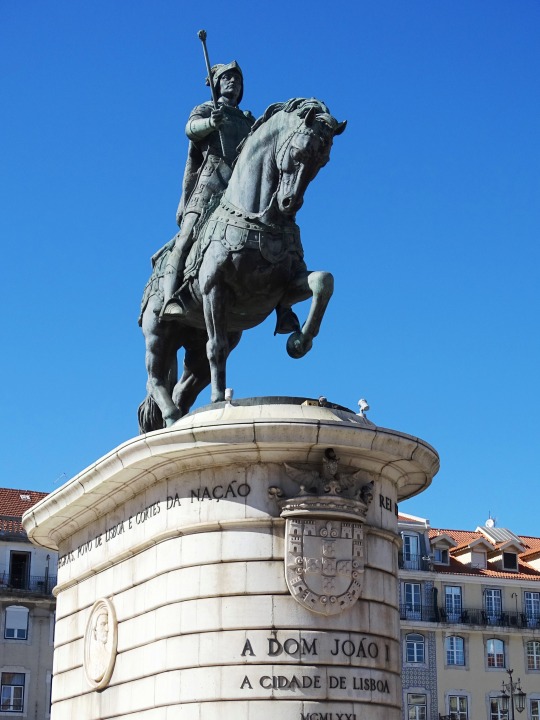



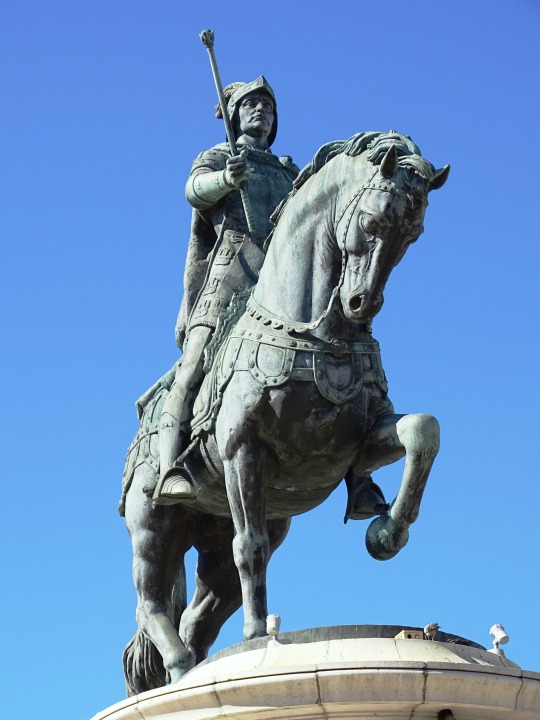


Portuguese Crisis of 1383–85
Battle of Aljubarrota: Portuguese forces commanded by John I of Portugal defeated the Castilian army of John I of Castile on August 14, 1385.
#King John I by Leopoldo de Almeida#São Jorge Castle#Lisbon#Lisboa#travel#Portugal#João I de Portugal#Praca da Figueira#Albufeira#Algarve#Atlantic Ocean#beach#Portuguese Crisis of 1383–85#Battle of Aljubarrota#John I of Portugal#won#14 August 1385#anniversary#Portugese history#Ourique#original photography#summer 2021#architecture#Southern Europe#cityscape#landscape#seascape
3 notes
·
View notes
Text
It was Gaunt who arranged Henry's marriage. The object of his attentions was Mary, the co-heiress to Humphrey de Bohun, earl of Hereford, Essex and Northampton, who had died at the age of thirty in January 1373, leaving no sons, two underage daughters, and a very substantial inheritance. The elder daughter, Eleanor (born in 1366), was married to Gaunt's brother, Thomas of Woodstock, earl of Buckingham, probably in 1374. What now happened to Mary (born in 1369–70) was naturally a matter of considerable interest to Buckingham. As long as she remained single, the entire Bohun inheritance would fall to him; were she to marry, he would be obliged to share it with her husband. Inconveniently, other duties now deflected his attention. On 3 May 1380, he indented with the king and council to lead an expedition to Brittany with a retinue of 5,000 men. During the following two months he did what he could to ensure that the Bohun patrimony did not slip from his grasp during his absence: on 8 May he obtained a royal grant of the custody of Mary's share of the inheritance during her minority; on 22 June Eleanor came of age and Thomas performed his fealty to the king for his wife's share of the lands. Shortly before leaving he even took the precaution of bringing Mary to stay with her sister at Pleshey castle (Essex), where he arranged for her to be instructed by nuns with the intention that she should join the order of St Clare. According to Froissart, ‘the young lady seemed to incline to their doctrine, and thought not of marriage’.
Hopeful of having ensured the integrity of his inheritance, Buckingham shipped his troops to Calais and, on 24 July 1380, set out with his army on a campaign from which he would not return for nine months. No sooner had he done so than Gaunt made his move. Three days after his brother's crossing, he secured a royal grant of Mary's marriage, ‘for marrying her to his son Henry’, and shortly after this induced her mother, Joan countess of Hereford, to spirit her away from Pleshey and take her to Arundel, where the young couple were rapidly betrothed. They were married on 5 February 1381 in a service held at Countess Joan's manor of Rochford (Essex). The connivance of the king and council, who would have been aware of the blow this inflicted on Buckingham, is a measure of the financial and political leverage Gaunt exercised in Richard II's minority government. Gaunt attended and presented Mary with a ruby, as well as paying for the festivities; Henry's sisters, Philippa and Elizabeth, each gave their new sister-in-law a goblet and ewer. The king and Edmund earl of Cambridge (Gaunt's younger, and Buckingham's older, brother) may also have been there, for ten royal minstrels and four of Cambridge's minstrels received gratuities from Gaunt for enlivening the proceedings. There was nothing hasty or clandestine about the wedding.
Chris Given-Wilson, Henry IV (Yale University Press, 2016)
#mary de bohun#henry iv#joan de bohun countess of hereford#john of gaunt#elizabeth of lancaster countess of huntingdon#philippa of lancaster queen of portugal#thomas of woodstock duke of gloucester#richard ii#historian: chris given-wilson#rebecca holdorph argues for an earlier wedding date iirc#also 'induced' joan to 'spirit' mary away? i don't think you could induce joan to anything she didn't want to#(ask john holland how he knows)#froissart's account of the wedding is problematic (refer to previous post) it presents the marriage as#a struggle for custody of mary between gaunt and woodstock - mary - the stolen bride - is effectively property in the narrative#(and the perspective of other women are ellided beyond the 'aunt' who abducted her who is presented as solely wanting to please gaunt)#(and the perspective of the other child/minor in the story - 13 yr old henry)#it's possible that mary did want to be a nun but it's also possible that froissart is fictionalising her perspective
7 notes
·
View notes
Text
Bejba, wake up! New Jann song just dropped... If u even care...
#BRO EVEN MADE IT TO NMF PORTUGAL WHAT DA HELL#Like a lot of times some big releases from big artists don't show up there and yet here he is lol#Brother in christ I have an important test today do you not have any compassion for my poor nerves#Eurovision#Eurovision 2023#If he doesn't run again in 2024 I'm gonna snap btw going John wick mode on tvp#Yeah yeah I lied it's June and I'm still in eurovision world WHAT DO YOU WANT FROM ME#Jann#wow anna said somehting#anna's shitposts
17 notes
·
View notes
Text

I fell from grace so I could land in your arms.
SpaPort for @hetaween-event-2022 day 7 - Angels & Demons / Cursed
The demons I’m familiar with are basically cursed angels, so ;) João’s beauty mark is a visual sign of their sin (loving each other more than their creator), and it marks the spot where Antonio first kissed him - under his eye, very softly, very innocently. When he drew back and spotted the sudden blemish, they both knew what it meant. And they made their choice.
#hetaween 2022#my art#spaport#hws portugal#hws spain#aph portugal#aph spain#wfsn#not really but just in case....#carnation pair#it's just a couple of cursed angels losing their holiness nothing exciting is going on#that's a melting halo but#cw blood#just in case#I thought two angels in love was more tragic#but I also considered angel/demon#especially after seeing that Asmodeus the demon of lust is opposed by.....St John lmao maybe next time i’ll do that#i actually have a permit to draw these things don't worry#but also a big thank you to the people giving their time to run this event you guys are wonderful
72 notes
·
View notes
Text
youtube
Now you’re fucked up, forever.
#i love you portugal the man#i love you john gourley#i love you thank you#portugal. the man#ptm#anxiety:clarity#heavy games#chris black changed my life#alaska#music
2 notes
·
View notes
Photo




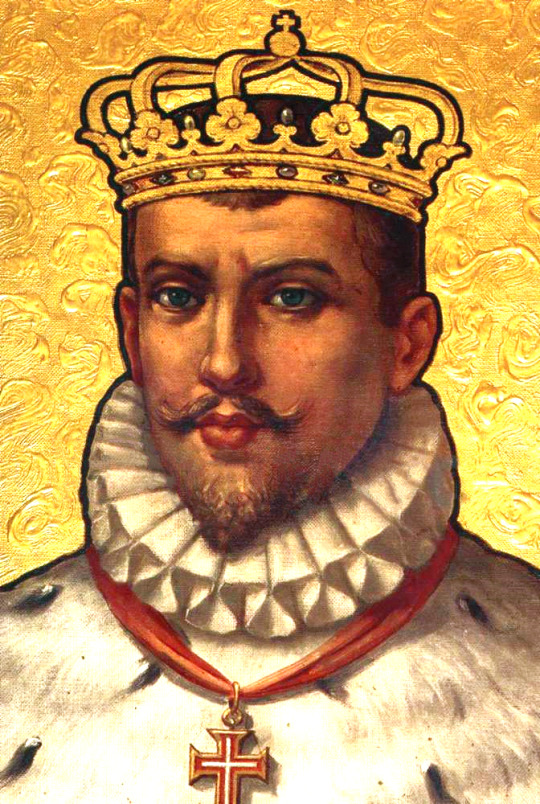

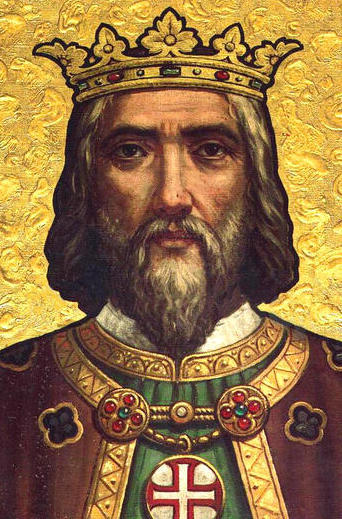
Portuguese monarchs: The House of Aviz.
#kingdom of portugal#reino de portugal#house of aviz#reis de portugal#john I#edward I#Afonso V#john ii#manuel I#john iii#sebastian I#list of monarchs#quinta da regaleira#sala dos reis
9 notes
·
View notes
Text

King John I of Portugal and D. Nuno Álvares Pereira, Constable of Portugal.
#king john i of portugal#nuno álvares pereira#portugal#kingdom of portugal#medieval#middle ages#knights#armour#europe#european
1 note
·
View note
Text
youtube
𝘐𝘴𝘢𝘣𝘦𝘭𝘭𝘢 𝘰𝘧 𝘊𝘢𝘴𝘵𝘪𝘭𝘦, 𝘍𝘦𝘳𝘥𝘪𝘯𝘢𝘯𝘥 𝘰𝘧 𝘈𝘳𝘢𝘨𝘰𝘯, 𝘵𝘩𝘦𝘪𝘳 𝘤𝘩𝘪𝘭𝘥𝘳𝘦𝘯 + 𝘵𝘩𝘦𝘪𝘳 𝘭𝘰𝘷𝘦𝘴
#isabella of castile#ferdinand ii of aragon#Isabel#Isabella of aragon#joanna the mad#joanna of castile#philip the handsome#catherine of aragon#henry viii#John of aragon#Maria of aragon#Manuel i of portugal#Michelle Jenner#Catalina de Aragon#Youtube
1 note
·
View note
Text
#JON SNOW FORTNIGHT EVENT 2023
@asoiafcanonjonsnow
DAY 10: ECHOES OF THE PAST 🗝️📜(2/2) ->
Historical parallels with Medieval bastard Kings.
John I of Portugal
To complete the the previous post of this meta, we're going to dive in the parallels and simmilarities between Jon Snow and John I of Portugal through the following points:
BASTARDY
John I of Portugal also known as John of Avis, was the bastard son of King Peter I of Portugal and Teresa Guille Lourenço, a Galician noblewoman, lady in waiting of Inês de Castro, or according to other sources, the daughter of some Lisbon merchants.
Jon Snow is officially known to be Ned Stark's bastard son, and if we consider R+L=J, he's Prince Rhaegar and Lyanna's son, and as far as we know Jon is still a bastard.
PARENT'S TRAGIC LOVE STORY
John I's father, Peter I of Portugal fell in love with Inês, a lady in waiting and cousin of Constanza Manuel de Villena (Peter's wife).
After Constanza died, they became lovers and they had four children and they wed in secret, but some Portuguese nobles and Peter's father, Afonso IV of Portugal, disliked their relationship because the possible influences of Inês' family. They plotted to kill her, Inés was killed by three of those men and it's said that when Peter became king, he put Inês' corpse in a throne next to him so that the people would swear allegiance to her as queen of Portugal and looked for revenge chasing the ones who killed Inês. John I was born a few years after Inês died when Peter I had an affair with Teresa Lourenço.
Jon's parents, Rhaegar and Lyanna met at the Harrenhal Tourney, in which both participated, Lyanna as the Knight of the Laughing Tree, Aerys sent Rhaegar some men to learn the identity of the mystery knight, so it's likely that Rhaegar figure it out and then crowned her as Queen of Love and Beauty when he won the tourney. They fell in love and run away together, Rhaegar died at the Battle of the Trident during Robert's rebellion and Lyanna died after giving birth to Jon at the Tower of Joy.
BROTHER IS THE KING
After Peter I of Portugal died, he was succeeded by his son with Constanza Manuel de Villena, Ferdinand I, and John held a prominent position during the reign of his brother.
Jon is a brother of the Night's Watch when Robb is proclaimed as King in the North and during his brief reign.
Apart from that it would be argued that Aegon VI fits here too because he's Jon's brother, but Young Griff's identity as Aegon VI is doubtful and he hasn't taken control of Westeros yet.
MILITAR EDUCATION AND CAREER
John was educated by Nuno Freire de Andrade, Master of the Order of Christ, and John became Master of the Order of Avís, one of the most important Orders in Portugal during the Middle Ages, from which he will take his last name.
Jon joined the Night's Watch, which can also be considered a militar order in which chastity is also imposed on its members just like the Order of Avis. Jeor Mormont, Lord Commander of the Night's Watch has been one of Jon's mentors, so just like John, Jon had the leader of a militar order as a mentor, and then became the head of a militar order.
RELATIONSHIPS/LOVE INTERESTS
While John formed part of the Order of Avis, despite vows of chastity, John had two bastard children with Inês Pires when he was a teenager, Beatrice and Afonso, 1st Duke of Braganza.
Jon broke his vows by falling in love and being with Ygritte, even though Jon didn't had children with Ygritte, and Jon has also expressed that he didn't want to have them because of the stigma of being a bastard and the classist Westerosi society.
POLITICAL MATCH MAKER
John was one of the negotiators of the successive marriage projects of his niece and the heiress Beatrice of Portugal, who would end up marrying John I of Castile (Henry II of Castile's son), as a way to seal peace after the Fernandine Wars, in which Ferdinand I tried to overthrow Henry II from the Castilian throne, who became king after killing his legitimate brother Peter I of Castile (who was Ferdinand I's cousin), and was supported by one of Peter I's legitimised bastard children, Constance of Castile.
In the agreements established that each one would independently reign their kingdoms and the offspring of both would inherit Portugal, although if Beatrice died without children, the heirs of her husband would inherit Portugal, and John I of Castile has children from a previous marriage to Eleanor of Aragon (this is important detail for later).
Jon has also arranged a wedding of a familiar during his time as head of the militar institucional, as the Karstarks originated as a cadet branch of the Starks, and there have been intermarriages between the two houses, so we could assume Alys and Jon are distant cousins, such as Alys and Sigorn's wedding.
PROBLEMS OF SUCESSION AND INDEPENDENCE OF THEIR KINGDOMS & THEIR RISE TO KINGSHIP
After the death of Ferdinand I, a succession crisis took place in Portugal between Beatrice, who had no offspring, and the children of Peter I of Portugal with Inés de Castro (who were considered bastards by the Portuguese nobility), and also John revolted at end of 1384 with the support of the commonfolk and the bourgeoisie, and promoted a war to maintain the independence of Portugal, adopting the title of defender of the kingdom, which he achieved by defeating Beatrice and John I of Castile, for which he was crowned king of Portugal, being the first king and founder of the House of Avis.
Due to what happened to John with the fight for the independence of Portugal against another family member, it is most likely that in TWOW when Jon arrives in Winterfell the inheritance problem between the Starklings will have to be solved, and with Robb's will and his position as the older brother and being the one with political experience, supported by the Free Folk, the Mountain Clans and some Northern Noble Houses like the recently created House of Thenn, formed by Alys and Sigorn, Jon will be named king in the North breaking relations with the Iron Throne that is under the control of the Lannisters and the North will be (for the moment) independent again. In addition, the matter of Beatrice and her husband John I of Castile reminds me a bit of the marriage of Sansa and Tyrion, being Tywin's initial plan to get the North under the rule of the Lannisters, although that did not work and the best method was having the Boltons at Winterfell. Plus both Tyrion and John I of Castile have lions in their sigils, although the Castilian lion is purple (or in some media, red) and the Lannister one is golden.
ALLIANCES, MARRIAGE & OFFSPRING/POSSIBLE MARRIAGE (SPECULATIONS)
Like his brother Ferdinand I, John supported Constance's cause, allying with her against John I of Castile, but they were defeated and Constance did not get the Castilian throne, her daughter Catherine of Lancaster married John I of Castile's son, Henry III, and their son was John II of Castile, thus uniting the two lines of succession of Alfonso XI of Castile.
As well as Peter I of Castile's two eldest surviving daughters married two of Edward III of England's sons (Constance married John of Gaunt, 1st Duke of Lancaster and Isabella married Edmund of Langley, 1st Duke of York), John I of Portugal married Philippa of Lancaster, John of Gaunt's eldest daughter with Blanche of Lancaster, and they had a loving marriage and eight children: Blanche, Afonso, Edward I of Portugal, Peter, Henry, Isabella, John and Ferdinand.
Edward was a poet and writer, his more important books were, on good governance,'The Loyal Counselor', 'Book of Councils', 'Response, being princes, to the infant D. Ferdinand about some complaints he had of his father'; on sports and horsemanship, with educational connotations, 'Teaching book about riding well in any saddle' and "Regiment to learn to play weapons'.
It's very likely that Jon will need to make more alliances to stablish his position as King in The North and preparing for the War for the Dawn and fight against the Others, and one way to do it it would be marrying someone with a prominent influence and a big army.
And although Dany hasn't landed on Westeros yet, due to her army and her influence as queen claimant to the Iron Throne, could be a good ally, and Dany would like to help due to her care for people who are needed, so probably Jon and Dany would join forces and eventually they could fall in love, marry and rule Westeros together.
Plus, if Jon ans Dany have children, one of them could be a poet like Edward I or a music composer and a bookworm like Rhaegar.
CUNNING/KNOWLEDGE
Contemporary writers state John that his position as a master of a religious military order made him an exceptionally learned king for the Middle Ages. His love for knowledge and culture was passed down to his children, who are collectively referred to by Portuguese historians as the illustrious generation, for example, Edward I the Eloquent and Peter were considered as two of the most learned princes of their time, and Henry the Sailor invested heavily in science and in the development of nautical activities.
Although Jon is often seen as a warrior, he has shown interest on knowledge and books too and he has been showing competences and skills for being a good leader and he's cunning good at politics and a good administrator, as he has been proving during his time as Lord Commander of the Night's Watch.
DRAGON IMAGERY
John I of Portugal's sigil has some elements that make me link him with Jon, his emblem has a crest with a dragon, which was usually used in the heraldry of the Portuguese Royal family, in which a dragon appears in the Royal crest or two green dragons as the supports of coat of arms, which makes me think of Rhaegal, a green dragon, who was named after Rhaegar and most likely Jon is its dragonrider.
#jonsnowfortnightevent2023#jonsnowfortnightevent#jon snow#meta#canonjonsnow#canonjon#jon meta#asoiaf meta#day 10#echoes of the past#historical parallels#john i of portugal#João I#medieval bastard kings
30 notes
·
View notes
Text
Burgundian Ambassadors Broker a Portuguese Marriage for Philip the Good, Duke of Burgundy
Burgundian Ambassadors Broker a Portuguese Marriage for Philip the Good, Duke of Burgundy
The oldest known view of Lisbon (c. 1500-1510) from the Crónica de Dom Afonso Henriques de Duarte Galvão (1435-1517)
In the year 1428 the most noble, most high, and most powerful prince my lord Philip, duke of Burgundy, who had successfully married two most noble ladies of exalted lineage, the first Lady Michelle, daughter of the most Christian, most excellent and most powerful prince King…

View On WordPress
#Burgundian history#Dom Duarte#Duchess of Burgundy#Duke of Burgundy#Elizabeth of Portugal#Isabel of Portugal#John I#King of Portugal#medieval history#Philip the Good#Portuguese History
1 note
·
View note
Photo
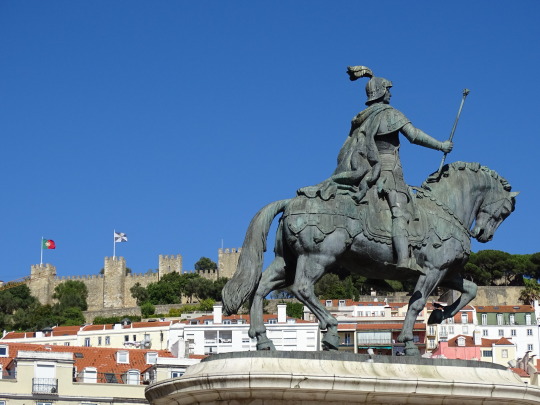

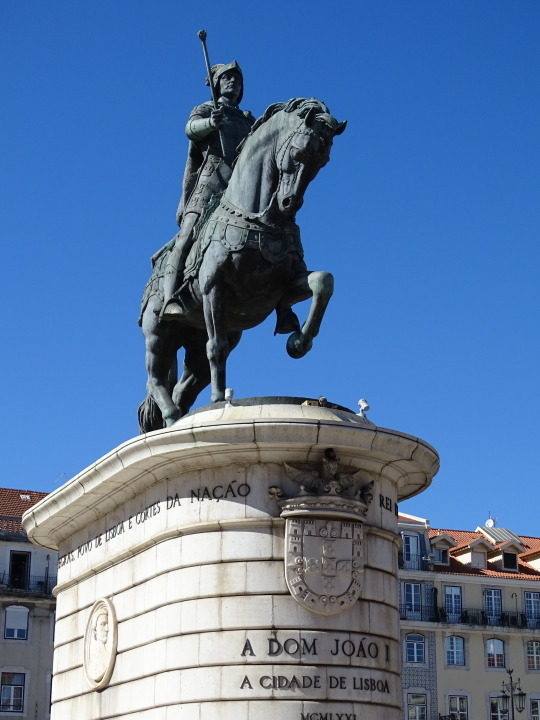





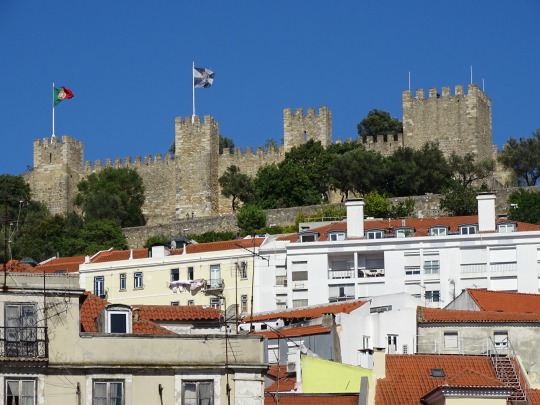
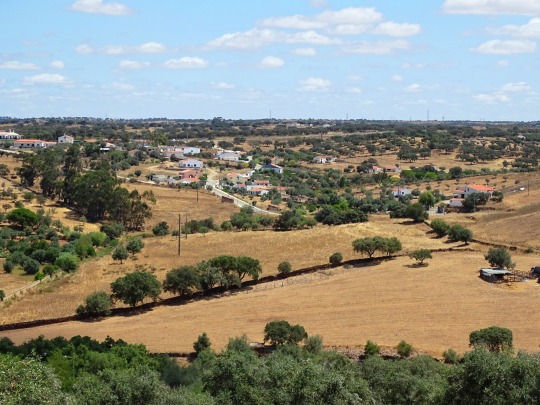
Portuguese Crisis of 1383–85: Battle of Aljubarrota: Portuguese forces commanded by John I of Portugal defeated the Castilian army of John I of Castile on August 14, 1385.
#King John I by Leopoldo de Almeida#John of Aviz#João I de Portugal#travel#Praca da Figueira#Lisbon#Lisboa#São Jorge Castle#Portugal#vacation#Portuguese Crisis of 1383–85#Battle of Aljubarrota#14 August 1385#anniversary#sculpture#public art#tourist attraction#landmark#original photography#architecture#cityscape#summer 2021#Atlantic Ocean#beach#Ourique#landscape#countryside
3 notes
·
View notes
Note
hi yes i’ve been craving cod content but writer’s block sucks so
can i get some headcanons for soap , ghost , and könig [seperate] w/ a gn!reader who generally acts cold and stoic but the second they’re alone or when they see something that catches their interest , they get really giddy ?
thank youuuuu
Simon ‘Ghost’
He absolutely loved seeing that spark in your eyes
The moment your eyes locked onto the limited edition art book for your favorite game, you were a goner
He saw the way you gingerly picked it up like you were going to break it and his heart melted
You were radiating excitement, clearly biting your tongue to keep yourself from bursting
So he decided to be the best boyfriend and ask you about it, and he was floored at how much you knew
You went on about how they took inspiration from different artists from different time periods and even listed the pieces they used, pulling them up on your phone to show him
Only going into further detail on the inspiration behind those art pieces, he was amazed by how much you knew about art
Your knowledge seemed endless and the excitement and awe in your voice was infectious
John ‘Soap’ MacTavish:
You’re never gonna live it down sweetheart
You both were driving home when a commercial on the radio came on announcing your favorite band, you gasped so hard it scared the shit out of him and he slammed the brakes
Then you quickly apologized and explained what happened, Johnny couldn’t stop laughing, despite your breathless giggles telling him to shut up
When you got home, Johnny bought the tickets and asked you to tell him everything about the band
You wasted no time putting together a playlist of their songs by order of your most to least favorite, even going so far as to explain why they’re your favorite and how they became your favorite
Your smile could light up the sky, he felt like he was right there with you when you recounted the first time you heard the songs and how you were feeling
Now that he knows this band is a catalyst for that enchanting side of you, he’ll do everything he can to bring it out of you
He lives for the sparkle in your eyes and the excitement in your voice, it’s addictive
König:
God he lives for those moments
Ever since that first time he saw you get so excited when you two walked past the pastry shop, he decided he only ever wanted to see that look on you forever
So he makes it a point to take you to different bakeries a few times a month, just so he can see that sparkle in your eyes
He’d ask you about the different pastries, where they come from, how they’re made, what are some different flavor combinations you’d recommend, he wants to know it all
And he’s watching you explain it all the whole time, chin resting on his palm, hearts in his eyes as you answer his questions diligently
He almost worries that you’re not breathing when you go into detail about why the egg custard pastry is such a valued desert in Portugal
God he loves seeing you get so excited, he loves the joy in your eyes, and he loves hearing all your knowledge, he could listen to you forever if you asked him to
#simon riley x reader#simon ghost riley x reader#ghost x reader#john mactavish x reader#john soap mactavish x reader#soap x reader#konig x reader#könig x reader#cod x reader#mw2 x reader#cod mw2#cod mwii
1K notes
·
View notes
Text
I'm on the train the entire time my country is playing and there's like an 85% chance there won't be wifi.... Bro I'm gonna DIE out here 😩😩💀😭‼️
#🐓🇵🇹😤🙏 Deus no comando irmãos (joking but not really)#wow anna said something#anna's shitposts#The neighbors are fightingggg#I'm p sure we're right above them on the map slightly it's the closest country in Africa me thinks#If all else fails hit them with a chouriço or posta de bacalhau godspeed kings 🤝😤 or throw a chinelo at them#Portugal X Morocco#Morocco x Portugal#On God we're gonna get our asses kicked fr 😭😭 it's been real ✌️#Wifi better work I can't live laugh love in these conditions girl you owe me today ffs#Portugal nt#portugal national team#World cup 2022#World cup#Sidenote it's 2am I'm on a hotel and the guy next door is playing John cenas theme loudly?? WHAT THE FUCK LMAOOO
11 notes
·
View notes
Text




Ok ok ok ok listen. Because I have anxiety I feel it's my duty to say that this show won't be for everyone. I came to it over quarantine because my husband suggested we read Bernard Cornwell's series together, and I agreed because I liked Hornblower and knew this was the army equivalent and, let's face it, I wanted to see scruffy mid-thirties Sean Bean in uniform.

THE PREMISE:
Richard Sharpe is a lowborn rank-and-file soldier in the 95th Rifles during the Napoleonic Wars who is raised to an officer after saving Sir Arthur Wellesley's life (this all happens differently in the books, but the basic event is the same). Throughout the series, he rises in the ranks thanks to his bravery and heroism/recklessness, but he's always caught between two worlds--trying to be a leader of common men while never being accepted by the rest of the highborn officers.
Let's start with the bad:
CONS:

Look, this is a 90s drama glorifying the British army. So like, there are gonna be issues. Women are mostly romantic side pieces to be wooed and rescued, and there are plenty of subplots, verbiage, and stereotypes that didn't age well. Production values are low for the first few and so you've got battle scenes with like fifteen guys and a horse, which honestly I find endearing. But no episode is more cringey than Sharpe's Gold. Due to legal issues, the script had to be rewritten with none of the original material, and it turned into this bizarro semi-supernatural horror involving Aztec gold (in Spain, yes). It's completely different from all the other episodes, and even Sean Bean didn't like it (he called it a "mish mash," which is true). It's such a weird piece of work that we almost stopped watching the show, but we continued, and we were relieved to find that the rest of the series is markedly better. History Hack podcast does a great dive into why this episode was so whack.
PROS:
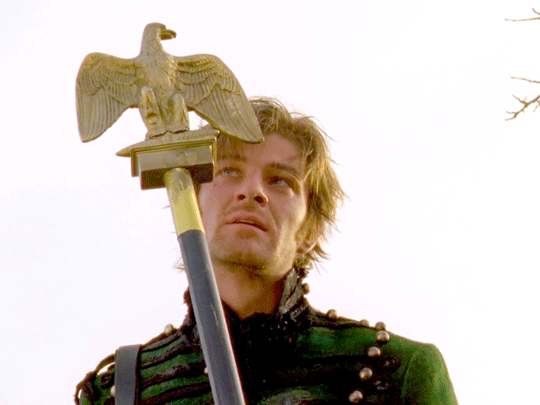
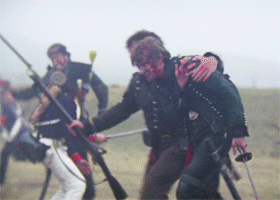

I MEAN COME ON
Sean really understood this character--absolute chaos on the battlefield and shy and awkward pretty much everywhere else. He's amazing in battle scenes and he's EPIC at acting wounded. But the scenes I replay over and over are when he's socially out of his depth and gets flustered and sputtery and so Sheffield the captions can't handle it.
Supporting cast:

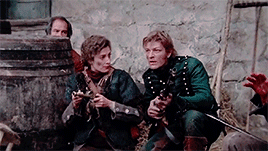
You'll find a lot of your classic British TV favorites making appearances throughout this series, and the camaraderie among the riflemen is always fun. Obviously this is a dude fest, as stated above, but some of the women are also written and acted really, really well--- Assumpta Serna as Teresa is that winning combination of a love interest/action heroine who doesn't devolve into a damsel in distress, and even passes the Bechdel test on a few occasions. And Diana Perez as Ramona is so badass and enjoyable.
Locations: Aside from a few interior sets, these films are mostly shot outside on location, with practical effects and stunts. There's some gorgeous scenery of the Crimean peninsula standing in for Spain and Portugal, and it's just really fun watching these guys run around rocky escarpments and fields with flares and stage explosives going off around them.

Music: I saw someone tag the opening theme as "electric guitar jumpscare" and they're not wrong. It's wonderfully anachronistic and totally 90s and you'll never get used to it. But far better are the soldiers' songs John Tams threads throughout, as well as his and Muldowney's thematic scores, and you will always, always finish an episode with him singing "Over the Hills and Far Away" stuck in your head.
Filming Lore: There was a LOT that happened during filming. Everything from Paul McGann having to drop out as the lead to misadventures in filming in Crimea just after the collapse of the Soviet Union. History Hack podcast has an awesome series of "filming of" episodes with input from cast, crew, and historians, and Jason Salkey (Rifleman Harris) has a book called "From Crimea With Love" that details the batshit filming adventures. I haven't read it but he references it every six minutes throughout the podcasts.
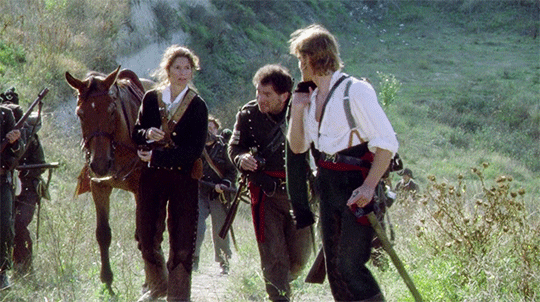
So: you've been warned, you've been primed. Start with Sharpe's Rifles; it's on Youtube. Watch it and Eagle, maybe jump to Battle or Siege if you're not sure, and then make up your mind.
If this all sounds enjoyable to you, but you wish there were more tall ships, more Paul McGann, more heroic brooding, and even MORE true love cosplaying as masculine camaraderie, you're in luck! Because you should also watch Hornblower!



And then draw fan art of it all! Please,,, I am so lon el y
311 notes
·
View notes